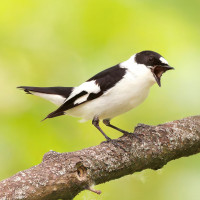Descripción
The Cigüeña Blanca breeding colony in Marchegg is located behind the castle. Just follow the signs leading to a path across a small bridge. Further nest sites are located on the roof of the castle and in the park around the castle so you can find different spots for great observations. The Cigüeña Blanca usually arrive at the end of March and occupy the old nests, which are then mended and prepared for the new season. In early April you can watch the storks displaying and mating and in May you can spot chicks in the nests. Later in summer one can observe the young ones learning to fly before they leave south in late August.
Apart from the watch tower next to the stork colony, there is a bird hide at a small lake, where Martín Pescador Común is often seen. Papamoscas Gris, Garza Real and sometimes also Garza Imperial can be found here as well, and if you are lucky you might spot a Charrán Común on its migration. Throughout the forest you can find (or rather hear) amongst others, Agateador Euroasiático, Papamoscas Acollarado, Curruca Capirotada, Mosquitero Común and several species of woodpecker.
This area is also home to rare amphibians (e.g. Moor frog (Rana arvalis), European fire-bellied toad (Bombina bombina)) and the European beaver (Castor fiber). Moreover, Konik horses are bred here and can be seen in their paddock next to the lake or foraging through the forest.
Continuing on the dam to the east of the castle, the tour takes you to the March river where you can find different species of swallows and might spot Milano Negro or Milano Real. Here the path turns to the south viewing a floodable meadow. Serín Verdecillo, Escribano Cerillo, Verderón Común, Alcaudón Dorsirrojo can be spotted here, among others.
Depending on the season, you can look for migrating waders at the small lake at the end of the circuit – or take a swim at its east side. You can take the same way back to the castle or stroll through the village back to the car park.
Detalles
Accesso
Best accessible by car. There is a car park next to Marchegg Castle.
Terreno y habitat
Bosque , Árboles y arbustos dispersos , Lago , Río , Ciudad/PuebloCondiciones
PlanoCamino circular
Sí¿Se necesita telescopio?
Puede ser útilBuena época para el avistamiento de aves
Primavera , VeranoMejor momento para visitar
Primavera , VeranoRuta
Camino anchoCamino difícil de andar
FácilAccesible vía
A pieEscondite de observación / plataforma
SíInformación extra
There is a WWF infopoint where you can obtain folders pointing out itineraries through the WWF nature reserve and the riparian forest. It is also possible to join guided tours through the area between May and October. However, since the paths are well marked, you will easily find your way through the area even when the infopoint is closed.





